
The almond is a species of tree from the genus Prunus cultivated worldwide for its seed, a culinary nut. Along with the peach, it is classified in the subgenus Amygdalus, distinguished from the other subgenera by corrugations on the shell (endocarp) surrounding the seed.

Rosaceae, the rose family, is a medium-sized family of flowering plants that includes 4,828 known species in 91 genera.
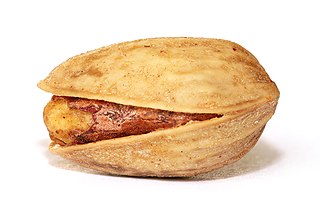
The pistachio, a member of the cashew family, is a small tree originating in Persia. The tree produces seeds that are widely consumed as food. The word can be countable or uncountable, meaning its plural is with or without an 's'.
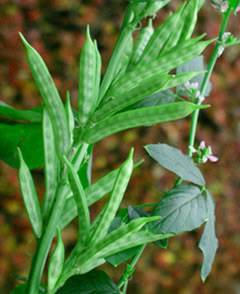
The guar or cluster bean, with the botanical name Cyamopsis tetragonoloba, is an annual legume and the source of guar gum. It is also known as gavar, gawar, or guvar bean. The genus name Cyamopsis means bean-like. The specific name is from Latin: tetragōnoloba meaning four-lobed.
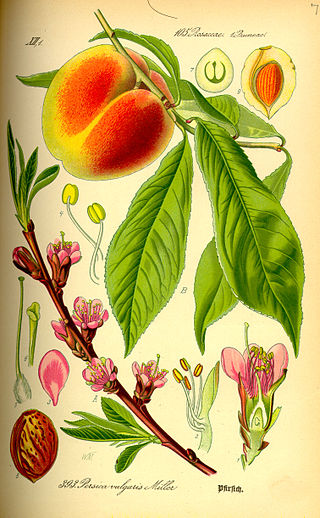
The peach is a deciduous tree first domesticated and cultivated in Zhejiang province of Eastern China. It bears edible juicy fruits with various characteristics, most called peaches and others, nectarines.

Saffron is a spice derived from the flower of Crocus sativus, commonly known as the "saffron crocus". The vivid crimson stigma and styles, called threads, are collected and dried for use mainly as a seasoning and colouring agent in food. The saffron crocus was slowly propagated throughout much of Eurasia and was later brought to parts of North Africa, North America, and Oceania.

Sorghum or broomcorn is a genus of about 25 species of flowering plants in the grass family (Poaceae). Some of these species are grown as cereals for human consumption, in pastures for animals as fodder, and as bristles for brooms. Sorghum grain is a nutritious food rich in protein, dietary fiber, B vitamins, and minerals.

Prunus is a genus of trees and shrubs in the flowering plant family Rosaceae that includes plums, cherries, peaches, nectarines, apricots, and almonds. The genus has a cosmopolitan distribution, being native to the North American temperate regions, the neotropics of South America, and temperate and tropical regions of Asia and Africa, There are 340 accepted species. Many members of the genus are widely cultivated for their fruit and for decorative purposes. Prunus fruit are drupes, or stone fruits. The fleshy mesocarp surrounding the endocarp is edible while the endocarp itself forms a hard, inedible shell called the pyrena. This shell encloses the seed, which is edible in some species, but poisonous in many others. Besides being eaten off the hand, most Prunus fruit are also commonly used in processing, such as jam production, canning, drying, and the seeds for roasting.

Asafoetida is the dried latex exuded from the rhizome or tap root of several species of Ferula, perennial herbs of the carrot family. It is produced in Iran, Afghanistan, Central Asia, northern India, and Northwest China (Xinjiang). Different regions have different botanical sources.

Prunus laurocerasus, also known as cherry laurel, common laurel and sometimes English laurel in North America, is an evergreen species of cherry (Prunus), native to regions bordering the Black Sea in southwestern Asia and southeastern Europe, from Albania and Bulgaria east through Turkey to the Caucasus Mountains and northern Iran.

The cowpea is an annual herbaceous legume from the genus Vigna. Its tolerance for sandy soil and low rainfall have made it an important crop in the semiarid regions across Africa and Asia. It requires very few inputs, as the plant's root nodules are able to fix atmospheric nitrogen, making it a valuable crop for resource-poor farmers and well-suited to intercropping with other crops. The whole plant is used as forage for animals, with its use as cattle feed likely responsible for its name.

Pistachio oil is a pressed oil, extracted from the fruit of Pistacia vera, the pistachio nut.

Prunus mahaleb, the mahaleb cherry or St Lucie cherry, is a species of cherry tree. The tree is cultivated for a spice obtained from the seeds inside the cherry stones. The seeds have a fragrant smell and have a taste comparable to bitter almonds with cherry notes.

Locust bean gum is a galactomannan vegetable gum extracted from the seeds of the carob tree and used as a thickening agent in food technology.

A crop wild relative (CWR) is a wild plant closely related to a domesticated plant. It may be a wild ancestor of the domesticated (cultivated) plant or another closely related taxon.

(R)-prunasin is a cyanogenic glycoside related to amygdalin. Chemically, it is the glucoside of (R)-mandelonitrile.
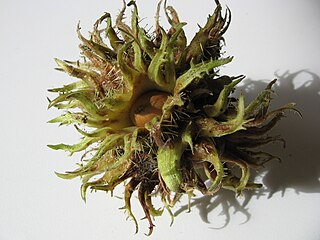
Husk in botany is the outer shell or coating of a seed. In the United States, the term husk often refers to the leafy outer covering of an ear of maize (corn) as it grows on the plant. Literally, a husk or hull includes the protective outer covering of a seed, fruit, or vegetable.
Prunus haussknechtii is a species of wild almond native to Iran. It is shrub or small tree 1–2 m tall, sometimes reaching 4 m, with pink flowers. It prefers to grow at 1200 to 3600 m above sea level, near water, either riverbanks or mountain bases where there is melting snow. It has the largest nut and seed of the 17 species of almond.
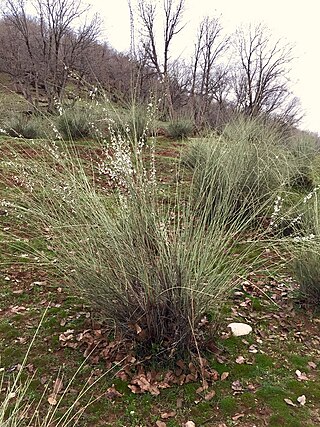
Prunus arabica is a species of wild almond found across the Middle East. It is a broomlike shrub typically 0.75 to 2 m tall, with brown bark. Its leaves have a 5-8 mm petiole and the leaf blades are 15 to 44 mm long and 3 to 10 mm wide. Its inflorescences have dark red hypanthia and sepals, and white, pale pink or pink petals. The flowers are borne on a pedicel about 3 mm long, which lengthens to 6 mm when the fruit is fully developed.
Prunus lycioides, sometimes known as Persian gum, is a species of wild almond native to Turkey, northern Syria and Iran. It is a very thorny and dense shrub 0.6 to 1.2 m tall. Its bark is gray and its flower petals are pink to deep pink, with its sepals and hypanthia deep red to purple. It is morphologically similar to Prunus erioclada, P. spinosissima, P. eburnea and P. brahuica. It can be distinguished from the similar species by its longer, narrower leaves, which are linear, linear‑lanceolate, or linear‑oblanceolate, and by subtle characters of its endocarp. Adapted to extremely dry conditions, it is found growing in a wide variety of arid and semiarid habitats, at 450 to 2200 m above sea level.




















